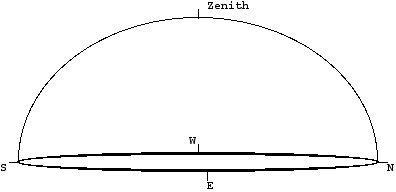BBBB Motions in the Sky - The Sun and the Seasons
Assume you are located in the city of Singapore, at a latitude of 1 degree North of the equator. On the diagram below, draw in and label the following: The North Celestial Pole, the Celestial Equator, the path of the Sun during a typical summer day (e.g. the summer solstice day).
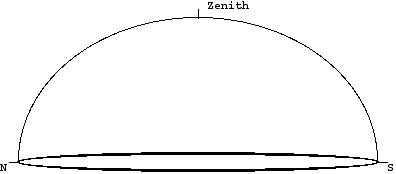
--
Assume you are located in New York City, at a latitude of 45 degrees North of the equator. On the diagram below, draw in and label the following: The North Celestial Pole, the Celestial Equator, the path of the Sun during a typical summer day (e.g. the summer solstice day).
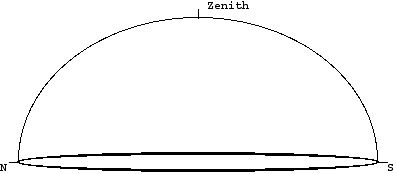
--
Assume you are located in Alaska, at a latitude of 65 degrees North of the equator. On the diagram below, draw in and label the following: The North Celestial Pole, the Celestial Equator, the path of the Sun during a typical summer day (e.g. the summer solstice day).
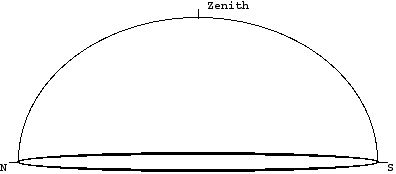
--
On the diagram below, assume you are standing at the Earth’s equator. Draw the location on the sky of (2 pts) the North Celestial Pole, (3 pts) the Celestial Equator, and (3 pts) the Sun’s daily path on June 21 (the summer solstice).

--
On the diagram below, assume you are standing at the south pole. Draw the location on the sky of (2 pts) the South Celestial Pole, (3 pts) the Celestial Equator, and (3 pts) the Sun’s daily path on December 21 (the summer solstice).
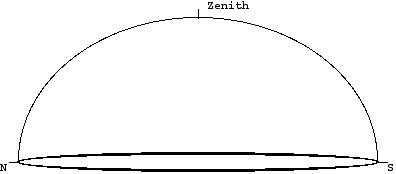
--
As seen from a latitude of 10 degrees South of the equator, draw in and label on the diagram below the following:
- (2 pts) South Celestial Pole
- (4 pts) Celestial Equator (indicate angle it makes with N or S horizon).
- (2 pts) Sun’s path on June 21
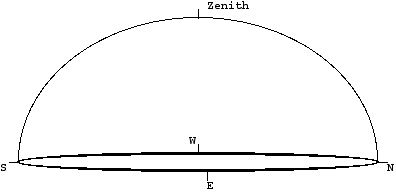
--
Assume you are located at a latitude of 65 degrees South. On the horizon diagram below:
a) (4 pts) Draw in (and label) the location of the South Celestial Pole and the Celestial Equator.
b) (4 pts) Draw in (and label) the location of the Sun’s typical daily path during June and December.
c) (4 pts) During “summer” days at this latitude, the Sun is above the horizon for more than 20 hours out of the day; however, temperatures at this latitude during “summer” are usually quite cool. Explain why.
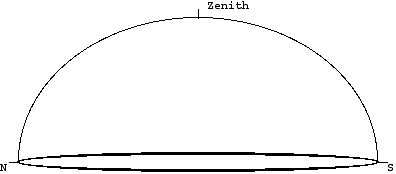
--
You overhear a conversation between two students. Joe Bob asks, "Why is it so hot during the summer?" Jim Bob says, "Since the northern hemisphere of Earth is tilted toward the Sun in Summer, the northern hemisphere is closer to the Sun than the southern hemisphere. That's why we have summer while they have winter." You know Jim Bob's explanation is wrong, but how would you argue against him? What reasoning would you use to convince them both that they are wrong? Explain.
--
The Copernican theory of the solar system states that the planets move in circular orbits around the Sun. When this idea was introduced, it conflicted with the centuries-old idea that the Earth is at the center of the solar system (with all the planets orbiting the Earth). Naturally, most people were unwilling to accept this new theory for the simple reason that it reflected a radical departure from the old view, supported by the church. Scientists have no such biases (at least, we like to tell that to ourselves, and we will assume that is the case here).
So you'd think that scientists would be quick to accept the Copernican theory, which is closer to the actual truth than the old geocentric model. In fact, most scientists did *not* accept the Copernican model. Explain two reasons why not (both reasons have to do with predictions made by the Copernican model that weren't seen to be true).
--
You overhear a conversation between two students. Joe Bob asks, "Why is it so hot during the summer?" Jim Bob says, "Easy, because the Earth is a lot closer to the Sun during the summer." You know Jim Bob's explanation is wrong, but what evidence would you provide to prove your case? Explain what you would say to disprove Jim Bob (I am *not* asking for you to explain the true reason for summer).
--
Sundogs are an atmospheric phenomenon often seen near sunrise or sunset when atmospheric conditions are correct.
a) (8 pts) Explain what sundogs are and what causes them.
b) (6 pts) If you see a sundog close to sunset and you notice the moon is high overhead, near its maximum altitude in the southern sky, what phase is the Moon in? Justify your answer in words or with a simple diagram.
--
For this problem, assume that the Earth's axis is not tilted toward or away from the Sun. In other words, the Earth's north pole points straight up, making an angle of 90° with respect to the ecliptic. Below is a celestial sphere with a tiny Earth in the center (north pole and equator are indicated on the Earth). On this celestial sphere, draw in and label the following (no explanations necessary for this problem):
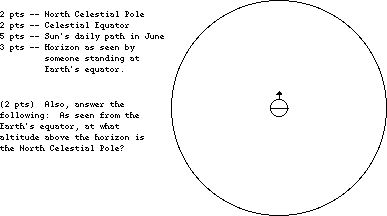
--
You read an article in the newspaper that claims the reason we have summer during the months of June, July and August is that the Earth is closer to the Sun during those months. Name and explain two pieces of evidence you would provide in response to contradict (prove wrong) this statement.
--
The diagram below shows the Earth during summer in the northern hemisphere. Use this diagram to show that observers at mid-latitudes (around 45° or so) in the northern hemisphere see the Sun at a higher altitude in the sky during the daytime and also that northern observers see longer days and shorter nights compared to those in the southern hemisphere.
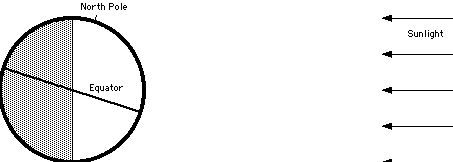
--
The diagram below shows the Celestial Sphere, with the Earth at the center (equator on Earth is shown), draw and clearly label the following (no explanations needed):
- The ecliptic (3 pts)
- The Sun's daily path in June (3 pts)
- The Sun's daily path in September (3 pts)
- The Sun's daily path in December (2 pts)
- The horizon as seen from a latitude of 45 degrees South (3 pts)
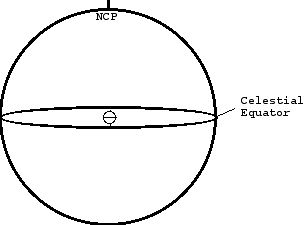
--
Let's assume for this problem that the Earth's axis makes an angle of 90° with respect to the plane of the ecliptic. On the horizon diagram below, draw in and label the following as seen from a latitude of 30° North (if things overlap, that's fine, just label clearly).
- (1 pts) North Celestial Pole (indicate altitude above horizon)
- (2 pts) Celestial Equator (indicate altitude above horizon)
- (2 pts) Sun's daily path on March 21 (the vernal equinox)
- (3 pts) Sun's daily path on December 21 (the winter solstice)
